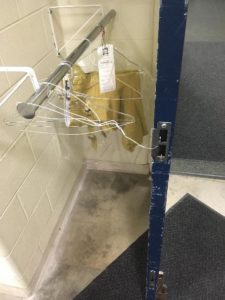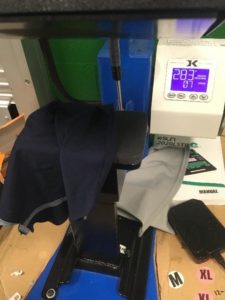Ideation Summary
Based on our four Guiding Principles, the team created three comprehensive ideas that would both enhance the student experience within Clay, while simultaneously highlighting the best parts of the school to prospective parents. Once students at Clay feel more comfortable and safe at school, we believe they will be more able and willing to learn and challenge themselves. In turn, we believe that a re-branding of Clay to highlight their strengths as an academic high school is necessary, and will help increase enrollment numbers in the coming years.
“Clay Pride” focuses on increasing student spirit and pride within the school. There could be an opportunity for a “Clay Day”, where bracelets, t-shirts, and artwork representing the school in a positive light are sold. The team also sees a need for a buddy or mentor program that spans across classes, which could help defuse some of the tension and violence students face. It could also provide opportunities for freshman to learn about opportunities in the school, and at its best, could even be used to solve conflicts or disciplinary issues in a non-traditional way. This idea focuses on the guiding principles, “Make me feel safe and comfortable” and “Help me find a strong community”.
- Clay Pride
- Clay Day / Share Joys
- Sell bracelets, shirts, Clay spiritwear
- Come together to fundraise for a charity or group in need of resources
- Organize effort to clean and paint the school
- Prepare a presentation or assembly where students show off talents
- Create Groups/Teams Across Years
- Mentorship style program
- Each student randomly placed in group with standard number of students from each grade in the school
- Monthly student led meetings with senior and junior leaders taking initiative of group discussions
- Competing throughout the year for prizes
- Encourage older students to help out the freshman with classes, clubs, personal issues, or anything else that comes up
- Student leaders on each team that provide feedback to Principal Eid, and report directly to him
- When a student is having a disciplinary issue, use the other students to help him/her resolve the problem
- Mentorship style program
Entice: Entice more prospective students by showing that Clay students and the school have a mutual commitment and dedication for each other. Various efforts organized by students, faculty, and family members, such as fundraisers, can be a good marketing tool for this.
Enter: Once students enroll into Clay, their first impressions must be positive, or at the very least meet student expectations. Results from the research carried out suggest a number of students felt they had been “conned” into enrolling in Clay with promises that were never really fulfilled. So while it is important to work towards rebranding Clay, it is equally important to do so taking into account student expectations and the school’s ability to meet them.
Engage: In order to truly engage new student in Clay, steps need to be taken to structure and encourage community building. In the long term this component will prove to be a critical aspect for Clay’s survival and growth. Furthermore it is the most sustainable approach to develop school pride. This form of intrinsic motivation aims to improve student perception of their own school which will hopefully lead to a better image and reputation and bolster Clay’s current enrollment level.
Exit: As students leave, there would be a transition of leadership from the outgoing seniors to the incoming ones. The buddy system that we envision will transition into the next year, as a whole new class of students come in. This will lead to mentees becoming mentors, and hopefully encourage them to be positive leaders around campus.
Extend: Through the various Clay Day / Share Joys activities and mentorship program, Clay graduates will have a strong sense of pride for the school. This will lead to positive word of mouth and reputation which will in turn contribute to increased enrollment numbers. Alumni may even donate in the future to Clay Day / Share Joys fundraisers in order to continue the philanthropic success of the events.
Our next idea is titled “Clay Connections”, and it involves partnering with schools in the area to increase the network that students can access. On an enrollment level, connections with elementary and middle schools would help direct more kids to Clay. However, there is also value in connecting with colleges in the area, so that students can access some of the programs or opportunities available to them through the universities. This idea supports the guiding principle “allow me to learn outside the classroom”, since the increased connections will widen their academic experience past the walls of Clay.
- Clay Connections
- Connect with Elementary/Middle Schools
- Meet with principals to find programs that Clay could continue to attract kids
- Ex. Continue Bilingual Program from Holy Cross Schools
- Coordinate a “Meet Clay High School” event for middle school parents looking to choose a high school for their child
- Put marketing information about Clay into middle school newsletters, bulletins, etc.
- Meet with principals to find programs that Clay could continue to attract kids
- Connect with local colleges
- Organize college fairs where students can meet with recruiters and learn about opportunities after graduation
- Organize college trips where kids can go see schools in the area, and learn what they need to do to be competitive applicants
- Organize programs with local colleges (Maybe Notre Dame) where students can tutor or mentor Clay kids
- Organize a program where College Students can come help coach sports teams, and in term become mentors/role models for students
Entice: We want to create Clay connections that expand the possibilities for students at Clay. Students will be enticed by the partnership Clay will have with the University of Notre Dame and the opportunities Clay students have to visit Notre Dame’s campus. Also Clay will position themselves as the top language high school in the South Bend area. Students will start a bilingual curriculum that extends from middle school through high school, providing students with 6 years of language education. This program will establish a strong language pipeline for students seeking to thrive in their language studies. The goal is for students to become bilingual through this program.
Enter: When students enter Clay one of the most immediate interactions with Clay connections will be enrollment in the Clay language program. They will be continuing the language education that started in their middle school education, which should allow for a smooth transition to high school language courses. Another area where Clay students should expect to see immediate Clay connections are within participation in Clay sports teams. Students from Notre Dame and other local colleges will be coaches on some of the Clay sports teams where Clay students will be interacting with and learning from college students on a daily basis during their sport’s season.
Engage: Clay Connections will secure student engagement by providing students with opportunities outside the classroom. Opportunities which wouldn’t be available in other academic institutions and which will allow them to have a more holistic education. Through partnerships with institutions such as Notre Dame and other higher education entities, students will be better positioned to pursue further education. This initiative intends to differentiate Clay from its competitors. Moreover, it will allow students to network and start building up their contacts. This is an opportunity which should appeal and motivate academically proficient students with the goal of attending a prestigious university. Also as a part of the Clay language program students will have the opportunity to spend a few weeks in a country which speaks the language the student was studying. This immersion in a foreign country would provide first hand experience in speaking the language learned.
Exit: In order to make this initiative successful, it is vital to build a strong alumni network. As students graduate Clay, it is important to retain contact and for them to encourage current Clay students to approach them and use them as a resource. Clay students who later are accepted and enroll at Notre Dame or Indiana University will be particularly valuable resources due to proximity. Overall, in order to make this effort sustainable, it is necessary to make expectations clear to Clay alumni and to help them grow into their new role as mentors.
Extend: There will be two main extensions from the Clay connections solution. One will be the continued use of the language learned through the 6 year Clay language program. Hopefully students of the program will continue to be able to use the language learned in daily lives as if they were bilingual and some students may even be able to seek jobs requiring dual language abilities. The other main extension will be the college placement success of Clay students. As more Clay students are accepted into better colleges, the Clay pipeline will grow stronger. The colleges will identify Clay as a school where they can trust that good students are coming from. Clay graduates will also continue to write letters of recommendation for Clay students and donate back to Clay because they are so proud of their school.
Finally, our last idea is named “Clay Marketing”, and involves re-branding the identity of the school. Rather than completely eliminate arts and shift to a more academic-focus, we believe that Clay should find ways to market their academic opportunities in conjunction with their strong arts magnet. This could involve highlighting AP class offerings and accelerated tracks to parents, so that they understand the tremendous opportunities their child will have at Clay. This idea supports the guiding principle “offer me opportunities to achieve academically” since the rebranding will shift the focus from Clay only as an arts school, to an educational center that has strong opportunities in the arts.
- Clay Marketing
- Update all marketing materials to better represent the best parts of Clay
- Increased focus on AP Program
- More balanced focus on academics and arts in unison
- Change name of the Clay magnet program to something that better represents the school, such as the Liberal Arts magnet
- Testaments from current students/graduates that highlight the best parts of Clay
- Maybe have some Clay graphic design students create the brochure, so parents can see the value of arts education
Entice: Based on our research, there seems to be either a void of information or misunderstanding on what Clay can actually offer to its students. A re-branding of the school is essential. Clay should find ways to market academic opportunities in conjunction with the arts magnet. Clay should focus on shifting away from just an “artsy school” to a educationally sound institution that also offers opportunities in the arts.
Enter: Similar to the “Clay Pride” idea, it is important that student expectations are met. Rebranding Clay is impossible unless actual student experiences are changed. In other words, it is essential to not overcommit for the sake of marketing the school by making promises that cannot be kept.
Engage: In order for this idea to be effective, Clay should allow its students to more actively contribute to the marketing process. When it comes to Clay’s strengths and weaknesses, the students know best. Moreover, this way the marketing process can be more effective as prospective students are more impressionable by peers of similar ages. It is also worth noting that a significant number of students take pride on the inclusive and accepting nature of Clay which should is an opportunity which definitely should be exploited.
Exit: Based on our research, one of the biggest factors in deciding a school is word of mouth. Positive word of mouth from graduates will be an effective yet cheap method of marketing and rebranding the school.
Extend: Testaments from various graduates that prospective students can look up to can have immensely positive marketing effects. Therefore, establishing a close-knit alumni network that can spread the positive Clay experiences can become a successful and sustainable method of marketing.


